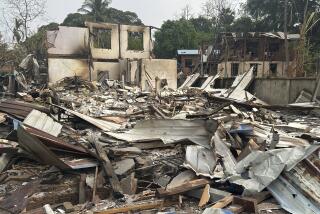Toll Climbs in Sri Lanka as India Troops Battle Tamils
- Share via
COLOMBO, Sri Lanka — Fierce fighting between Indian troops and Tamil Tiger guerrillas raised death tolls on both sides Monday, increasing the bloody price that India is paying for its military intervention in this island nation, according to Indian and Sri Lankan officials.
The continued combat in densely populated areas produced concerns over civilian casualties.
India also moved Monday against guerrilla camps across the Palk Strait in the nearby Indian state of Tamil Nadu, seizing an important communications center used by the Tigers to direct fighting on the island, Indian news agencies reported.
Head-to-head fighting with the Liberation Tigers of Tamil Eelam, largest and most powerful of the Tamil separatist guerrilla groups, spread to the eastern region near Batticaloa, where residents reported heavy artillery fire as a battle raged all Monday afternoon.
“Since 11 this morning there has been an engagement between the Liberation Tigers and the Indian peacekeeping force near Morakottachenai” (Batticaloa district), Indian diplomat Laksmi Puri said Monday evening, adding, “Fighting is still continuing.”
Battles also continued in three urban areas of the Jaffna Peninsula, including the old fort area of Jaffna city and the grounds of a Hindu temple, which Indian military officers were using as an evacuation site for Tamil civilians.
Officials estimated that the current Indian military campaign--the country’s first beyond its borders since the 1971 Bangladesh war--will take 10 days to complete.
Puri, the Indian spokeswoman in Colombo, said intercepted guerrilla radio communications indicated that 163 Tigers have died in the fighting. However, she said that only 13 bodies of Tamils have actually been recovered from the battle sites in the city of Jaffna, which has a population of 120,000. She said that four Tamil guerrillas were captured Monday in Jaffna, bringing the total of those arrested to more than 260.
Puri said that 18 Indian soldiers have been killed in the three days of fighting, including three parachute commandos shot as they jumped from a helicopter Monday, and that 74 others have been wounded.
The troops are part of a 12,000-man Indian peacekeeping force brought to the island under terms of a July 29 peace plan initiated by India to end a bloody five-year ethnic war between Tamil separatists and Sri Lankan government forces.
Wear Cyanide Capsules
Poised against the Indian army, the fourth largest in the world, are an estimated 3,000 Tamil Tiger guerrillas who wear cyanide capsules around their necks to commit suicide rather than be captured.
Although unable to match Indian firepower, the Tigers remain heavily armed with weapons and explosives, in violation of their agreement to surrender weapons as part of the July peace agreement signed by Prime Minister Rajiv Gandhi of India and President Junius R. Jayewardene of Sri Lanka.
In the bitter ethnic war that preceded the Indian intervention, more than 5,000 people died, including many in civilian massacres by both sides.
Before its involvement, India was often highly critical of Sri Lankan military behavior against the Tamils. Several Tamil guerrilla groups were permitted to maintain bases and even training camps on Indian soil.
After the fighting of the past three days, however, India finds itself accused of engaging in civilian killings and excessive use of force, including employment of tanks and Soviet-made armored personnel carriers with mounted 76-millimeter cannons.
To protect its own troops, it has been forced to close guerrilla camps that it previously allowed to operate in Indian territory, including a sophisticated Tamil Tiger radio communications center.
A persistent report that 15 Tamil civilians have been killed by Indian troops near a large Hindu temple at Nallur, outside Jaffna, caused a moderate Tamil political organization to express concerns to Indian Ambassador J. N. Dixit.
In his representation, P.S. Soosaithasan, a leader with the moderate Tamil United Liberation Front political party, cited reports that the civilians had been killed trying to make their way to an evacuation center set up by the Indians at the Nallur temple.
Indian officials would not comment specifically on the Nallur incident. Spokeswoman Puri said, “We are doing everything we can to prevent civilian casualties.”
However, the Indian government radio network, All India Radio, broadcast from the mainland Monday reports that the Tigers were using “human shields” of civilians to separate themselves from the Indian troops.
Tamil Tiger spokesmen in Madras and London have charged Indian troops with “genocide” in the recent offensive. Reacting to the genocide charge, Puri said, “They (the Tigers) are hardly in a position to accuse anyone of genocide.”
Indian military actions came after the Tigers were charged with killing more than 150 civilians in massacres in the eastern province of this island nation, formerly known as Ceylon. Generally, the majority Sinhalese population on the island, including President Jayewardene in a speech Sunday night on national television, has reacted positively to the Indian military involvement.
To many Sinhalese who felt India favored the Tamil side in the ethnic conflict, India’s willingness to take on the Tigers in combat is a demonstration of unbiased commitment to the July 29 peace agreement.
“We are determined by all means available to resist those who would obstruct the implementation of the Indo-Sri Lankan peace agreement,” Puri said.
Puri said the three main objectives of Indian army actions are to “neutralize those elements that fire at the Indian peacekeeping force,” to “search for and capture arms and ammunition stocks” and to “destroy Liberation Tiger bases and camps.”
More to Read
Sign up for Essential California
The most important California stories and recommendations in your inbox every morning.
You may occasionally receive promotional content from the Los Angeles Times.













